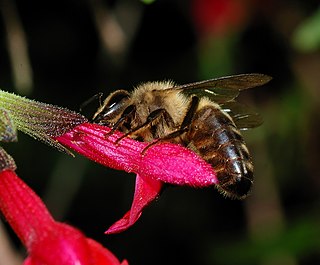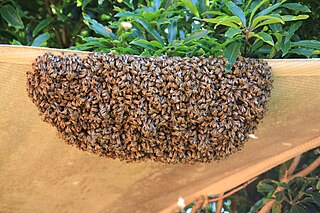
A honey bee is a eusocial flying insect within the genus Apis of the bee clade, all native to mainland Afro-Eurasia. After bees spread naturally throughout Africa and Eurasia, humans became responsible for the current cosmopolitan distribution of honey bees, introducing multiple subspecies into South America, North America, and Australia.

The Africanized bee, also known as the Africanized honey bee and colloquially as the "killer bee", is a hybrid of the western honey bee, produced originally by crossbreeding of the East African lowland honey bee (A. m. scutellata) with various European honey bee subspecies such as the Italian honey bee (A. m. ligustica) and the Iberian honey bee (A. m. iberiensis).

Beekeeping is the maintenance of bee colonies, commonly in man-made beehives. Honey bees in the genus Apis are the most commonly kept species but other honey producing bees such as Melipona stingless bees are also kept. Beekeepers keep bees to collect honey and other products of the hive: beeswax, propolis, bee pollen, and royal jelly. Other sources of beekeeping income include pollination of crops, raising queens, and production of package bees for sale. Bee hives are kept in an apiary or "bee yard".

The Buckfast bee is a breed of honey bee, a cross of many subspecies and their strains, developed by Brother Adam, who was in charge of beekeeping from 1919 at Buckfast Abbey in Devon in the United Kingdom. Breeding of the Buckfast bee is now done by breeders throughout Europe belonging to the Federation of European Buckfast Beekeepers (G.D.E.B.). This organization maintains a pedigree for Buckfast bees, originating from the time of Brother Adam.

A queen bee is typically an adult, mated female (gyne) that lives in a colony or hive of honey bees. With fully developed reproductive organs, the queen is usually the mother of most, if not all, of the bees in the beehive. Queens are developed from larvae selected by worker bees and specially fed in order to become sexually mature. There is normally only one adult, mated queen in a hive, in which case the bees will usually follow and fiercely protect her.

The European dark bee is a subspecies of the western honey bee, evolving in central Asia, with a proposed origin of the Tien Shan Mountains and later migrating into eastern and then northern Europe after the last ice age from 9,000BC onwards. Its original range included the southern Urals in Russia and stretched through northern Europe and down to the Pyrenees. They are one of the two members of the 'M' lineage of Apis mellifera, the other being in western China. Traditionally they were called the Black German Bee, although they are now considered endangered in Germany. However today they are more likely to be called after the geographic / political region in which they live such as the British Black Bee, the Native Irish Honey Bee, the Cornish Black Bee and the Nordic Brown Bee, even though they are all the same subspecies, with the word "native" often inserted by local beekeepers, even in places where the bee is an introduced foreign species. It was domesticated in Europe and hives were brought to North America in the colonial era in 1622 where they were referred to as the English Fly by the Native Americans.

The Caucasian honey bee is a subspecies of the western honey bee.

Swarming is a honey bee colony's natural means of reproduction. In the process of swarming, a single colony splits into two or more distinct colonies.

The dwarf honey bee, Apis florea, is one of two species of small, wild honey bees of southern and southeastern Asia. It has a much wider distribution than its sister species, Apis andreniformis. First identified in the late 18th century, Apis florea is unique for its morphology, foraging behavior and defensive mechanisms like making a piping noise. Apis florea have open nests and small colonies, which makes them more susceptible to predation than cavity nesters with large numbers of defensive workers. These honey bees are important pollinators and therefore commodified in countries like Cambodia.

Apis dorsata, the rock bee or giant honey bee, is a honey bee of South and Southeast Asia. They are typically around 17–20 mm (0.7–0.8 in) long and nests are mainly built in exposed places far off the ground, like on tree limbs, under cliff overhangs, and under buildings. These social bees are known for their aggressive defense strategies and vicious behavior when disturbed. Though not domesticated, indigenous peoples have traditionally used this species as a source of honey and beeswax, a practice known as honey hunting.
The Maltese honey bee, Apis mellifera ruttneri, is a subspecies of the western honey bee, endemic to the Maltese islands which are situated in the Mediterranean Sea.

The western honey bee or European honey bee is the most common of the 7–12 species of honey bees worldwide. The genus name Apis is Latin for "bee", and mellifera is the Latin for "honey-bearing" or "honey carrying", referring to the species' production of honey.
Varroa sensitive hygiene (VSH) is a behavioral trait of honey bees (Apis mellifera) in which bees detect and remove bee pupae that are infested by the parasitic mite Varroa destructor. V. destructor is considered to be the most dangerous pest problem for honey bees worldwide. VSH activity results in significant resistance to the mites.
Beekeeping is first recorded in Ireland in the seventh century. It has seen a surge in popularity in modern times, with the membership of beekeeping associations exceeding 4,500. The median average number of hives per beekeeper is three hives, while the average honey output per hive is 11.4 kg. The growth in the practice has occurred despite increased pressures on bees and beekeepers due to parasites, diseases and habitat loss.

Melipona beecheii is a species of eusocial stingless bee. It is native to Central America from the Yucatán Peninsula in the north to Costa Rica in the south. M. beecheii was cultivated in the Yucatán Peninsula starting in the pre-Columbian era by the ancient Maya civilization. The Mayan name for M. beecheii is xunan kab, which translates roughly to "regal lady bee". M. beecheii serves as the subject of various Mayan religious ceremonies.
The Foundation for the Conservation of the Maltese honey bee is a Maltese non-governmental organisation aimed at the protection and conservation of the Maltese honey bee, a subspecies of the western honey bee.
Apis mellifera artemisia is the Russian steppe honey bee, first identified in 1999 near Kyiv, Ukraine, by only one specimen, but by 2011 its taxonomic status had been called into question, although to date no DNA analysis has been conducted: At the same time the taxonomic status of the Apis mellifera ruttneri on Malta was also called into question, however in 2017 it was confirmed that Apis mellifera ruttneri was a new and separate subspecies.
Apis mellifera sossimai extending from the west of Ukraine centrally and southwards towards the Caucasus mountains. However in 2011 research from Russia conducted mtDNA analysis showing that the A. m. sossimai was not a separate subspecies, but only an ecotype of the Apis mellifera macedonica subspecies.















